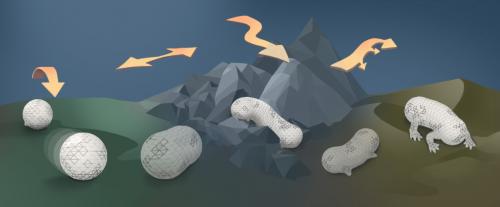Rebecca Kramer-Bottiglio Wins NSF EFRI Award For Shape-Shifting Robots

Robots designed for the purpose of exploring unknown landscapes, such as the famed Mars Rover, are limited by their lack of adaptability. A robot that can sense and adapt to its environment would enable navigation of varied terrains. With a $2 million grant from the National Science Foundation (NSF), Rebecca Kramer-Bottiglio is leading a team that is combining a sculptor’s intuition with shape-shifting technology to develop morphing, adaptable robots.

The four-year grant, part of the NSF’s Emerging Frontiers in Research and Innovation (EFRI) program, will fund a project to create morphing robotic systems that change their shape to enable multi-task performance in changing terrains or environments
The new shape-shifting robots will use “robotic skins” – flat, skin-like robots developed by Kramer-Bottiglio, assistant professor of mechanical engineering & materials science. Made with elastic sheets embedded with sensors and actuators, robotic skins can be wrapped around soft deformable objects to control those objects from their surface. For the new project, Kramer-Bottiglio and team will apply the robotic skins to moldable materials, such as clay, to sculpt the material from its surface, similar to how a sculptor changes the shape of clay with her hands.
The project team includes Madhu Venkadesan, assistant professor of mechanical engineering & materials science at Yale; Joshua Bongard, a computer scientist from the University of Vermont; and Michael Levin, a biologist from Tufts University. The team is also collaborating with Susan Clinard, a New Haven-based sculptor.

The researchers are leaning on Clinard’s sculpting expertise to generate initial morphing paths between shapes of interest. They will use this initial data to train an evolutionary algorithm to generate its own morphing paths in the future.
Preliminary results have produced a robot that starts as a rolling ball, then morphs into a worm-like robot that inches along. Through this project, the researchers hope to achieve more complex shape changes, such as a ball that morphs into a legged robot.
“A robot that can change its shape and gait would be able to navigate complex environments more efficiently,” Kramer-Bottiglio said. “We believe our unique sculpture-inspired approach will enable new contextually-sensitive robots that can adjust their morphology and behavior to meet the demands of unpredictable environments.”

